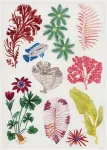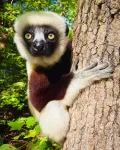From corals to crops: How life protects the plans for its cellular power stations
2021-04-23
(Press-News.org) An international team of researchers led by the University of Bergen has uncovered how organisms from crops to corals may avoid deadly DNA damage during evolution.
Our cells, and those of animals, plants and fungi, contain compartments that produce chemical fuel. These compartments contain their own DNA, which stores instructions for important cellular machinery. But this so-called oDNA (organelle DNA) can become mutated, corrupting the instructions and preventing cells making enough energy.
In humans and some other animals, a process called the "bottleneck" allows some offspring to inherit less mutated oDNA. This process needs mothers' egg cells to develop early, like in humans, where a human girl is born with all her egg cells already formed. But other organisms, from plants to fungi, don't develop these cells early - their flexible body plans mean that eggs are not "set aside" early in development.
"We wanted to know how these organisms might avoid inheriting mutations without a human-like bottleneck," said Ellen Røyrvik, a geneticist on the research team, based at UiB.
The scientists used mathematical modelling to show that a process called gene conversion - the controlled overwriting of DNA - could in theory allow some offspring to inherit less mutant oDNA without requiring a bottleneck. Using genome data, they found machinery controlling this process in plants and fungi, but also in soft corals, sponges, and algae - all organisms without fixed body plans. They also found that this machinery was most active in the parts of plants that will end up producing the seeds of the next generation, suggesting that it is indeed used to allow some offspring to inherit fewer mutations.
"Taken together, it looks like organisms without a fixed body plan - plants, fungi, corals, sponges, algae - may have adopted gene conversion to deal with oDNA mutations," said Iain Johnston, an associate professor in the Mathematics Institute at UiB, who led the research. "Humans and other animals can develop egg cells early and use a bottleneck; other organisms can use gene conversion instead."
Going forward, the team plans to explore how this overwriting of oDNA causes other issues in the organisms that use it - including crop plants, where it can cause sterility. They are also exploring the broader question of why these compartments contain oDNA at all, given the risk of mutational damage.
The research, funded by the European Research Council, will appear in
PLOS Biology.
INFORMATION:
[Attachments] See images for this press release:

ELSE PRESS RELEASES FROM THIS DATE:
2021-04-23
DURHAM, N.C. - Fruits and veggies are good for you and if you are a lemur, they may even help mitigate the effects of habitat loss.
A new study sequencing the genome of four species of sifakas, a genus of lemurs found only in Madagascar's forests, reveals that these animals' taste for leaves runs all the way to their genes, which are also more diverse than expected for an endangered species.
Sifakas are folivores, meaning that the bulk of their diet is composed of leaves. Leaves can be difficult to digest and full of toxic compounds meant to prevent them from being eaten. Unlike our carefully selected spinach, tree leaves also don't taste great, and are not very nutritious.
Because of that, leaf-eaters ...
2021-04-23
Strenuous efforts to prevent and treat malaria in recent decades have brought great benefits, particularly against disease caused by Plasmodium falciparum in countries in Africa and the Americas. But malaria caused by its "stealthier and more resilient cousin", P. vivax, now needs to be confronted with high priority, say Lorenz von Seidlein and Nicholas White of the Mahidol Oxford Tropical Medicine Research Unit in Bangkok, Thailand in a Perspective. The piece introduces a Collection on the prevention and treatment of P. vivax malaria in the open access journal PLOS Medicine, published ahead of World Malaria Day on April 25th.
In a Review article in the Collection, Sarah Auburn of the Menzies School of Health Research and Charles Darwin University, Darwin, Australia ...
2021-04-23
Extremist perpetrators of violence often quote verses from their religion's holy scriptures that authorize, or even prescribe, attacks on enemies of the faith. Abdullah H., the Syrian now on trial who stabbed a homosexual couple with a knife and killed a man in Dresden in October 2020, also testified that he had been inspired to commit the crime by a Quranic sura. However, whether the religious motivation that extremist perpetrators of violence emphasize is causally related to their actions is often doubted. Now, WZB researchers Ruud Koopmans and Eylem Kanol can prove for the first time that verses in religious scriptures that legitimize violence can increase support for killing enemies of the faith.
Together with Dietlind Stolle, a German-Canadian ...
2021-04-23
In a rare exchange, scientists and water resources engineers from Iran and Utah are collaborating on a bold scientific study to restore one of the world's largest saline lakes.
Lake Urmia -- a massive salt lake in Iran's northwest and a sister to Utah's Great Salt Lake -- has lost nearly 95 percent of its volume over the last two decades. As water levels drop, salinity spikes, threatening the lake's brine shrimp population and the flamingos and other bird species that depend on the shrimp for food. Lake levels are so low that at some coastal resorts, tourism boats must be pulled a kilometer (0.6 mile) or more from shore by tractor before reaching suitable depths. In addition, new land bridges are forming in the drying lake bed which allows mainland predators ...
2021-04-23
Over the last 60 years, scientists have been able to observe how and when genetic information was replicated, determining the existence a "replication timing program", a process that controls when and in what order segments of DNA replicate. However, scientists still cannot explain why such a specific timing sequence exists. In a study published today in Science, Dr. David Gilbert and his team have answered this 60-year-old question.
"Why would cells care about the order in which they replicate DNA?" asked lead scientist Dr. Gilbert. "After all - all cells need to replicate all their DNA. Our hypothesis has been ...
2021-04-23
A lobster's underbelly is lined with a thin, translucent membrane that is both stretchy and surprisingly tough. This marine under-armor, as MIT engineers reported in 2019, is made from the toughest known hydrogel in nature, which also happens to be highly flexible. This combination of strength and stretch helps shield a lobster as it scrabbles across the seafloor, while also allowing it to flex back and forth to swim.
Now a separate MIT team has fabricated a hydrogel-based material that mimics the structure of the lobster's underbelly. The researchers ran the material through a battery of stretch and impact tests, and showed ...
2021-04-23
What The Study Did: This simulation modeling study estimates the benefits of identifying silent COVID-19 infections among children as a proxy for their vaccination.
Authors: Alison P. Galvani, Ph.D., of the Yale School of Public Health in New Haven, Connecticut, is the corresponding author.
To access the embargoed study: Visit our For The Media website at this link https://media.jamanetwork.com/
(doi:10.1001/jamanetworkopen.2021.7097)
Editor's Note: The article includes conflict of interest and funding/support disclosures. Please see the article for additional information, including other authors, author contributions and affiliations, conflict of interest and financial disclosures, ...
2021-04-23
What The Study Did: Baseline corrected QT interval (QTc) on 12-lead electrocardiograms and ensuing changes among patients with and without COVID-19 are evaluated in this study.
Authors: Marc P. Waase, M.D., Ph.D., and Elaine Y. Wan, M.D., of the Columbia University Irving Medical Center in New York, is the corresponding author.
To access the embargoed study: Visit our For The Media website at this link https://media.jamanetwork.com/
(doi:10.1001/jamanetworkopen.2021.6842)
Editor's Note: The article includes conflict of interest and funding/support disclosures. Please see the article for additional information, including other authors, author contributions and affiliations, conflict of interest and financial disclosures, and funding ...
2021-04-23
What The Study Did: This study examines the test result positivity rate and health outcomes of maternal SARS-CoV-2 infection among perinatally exposed newborns.
Authors: Asimenia Angelidou, M.D., Ph.D., of Beth Israel Deaconess Medical Center in Boston, is the corresponding author.
To access the embargoed study: Visit our For The Media website at this link https://media.jamanetwork.com/
(doi:10.1001/jamanetworkopen.2021.7523)
Editor's Note: The article includes conflict of interest and funding/support disclosures. Please see the article for additional information, including other authors, author contributions and affiliations, conflict of interest and financial ...
2021-04-23
BOSTON - At the start of the COVID-19 pandemic, very little was known about SARS-CoV-2, the virus that causes COVID-19. Over the past year, more evidence has become available on how the virus is transmitted, who is at the greatest risk and best practices to prevent exposure. Yet questions still remain about how the virus impacts the health of pregnant women and newborns.
In a new study published in JAMA Network Open, physician-researchers from Beth Israel Deaconess Medical Center (BIDMC), Brigham and Women's Hospital, Boston Children's Hospital and Massachusetts General Hospital reveal that, while ...
LAST 30 PRESS RELEASES:
[Press-News.org] From corals to crops: How life protects the plans for its cellular power stations




